Rutabaga was bred in Sweden in the seventeenth century and immediately gained popularity. However, in Russia they started talking about it only at the end of the past century. This root crop has a lot of useful properties and is used not only in cooking, but also in traditional medicine.
Material Content:
- 1 Rutabaga and turnip - what's the difference?
- 2 Rutabaga - what is this vegetable, composition and nutritional value
- 3 Useful properties of rutabaga for the human body
- 4 Treatment of rutabaga diseases at home
- 5 How is the vegetable used in cosmetology?
- 6 What to cook from rutabaga - recipes
- 7 Contraindications to the use of swede
- 8 How to grow rutabaga in the garden?
Rutabaga and turnip - what's the difference?
In appearance, rutabaga is not difficult to confuse with turnips, which is not surprising, since these plants are related. However, a detailed study reveals a number of differences.
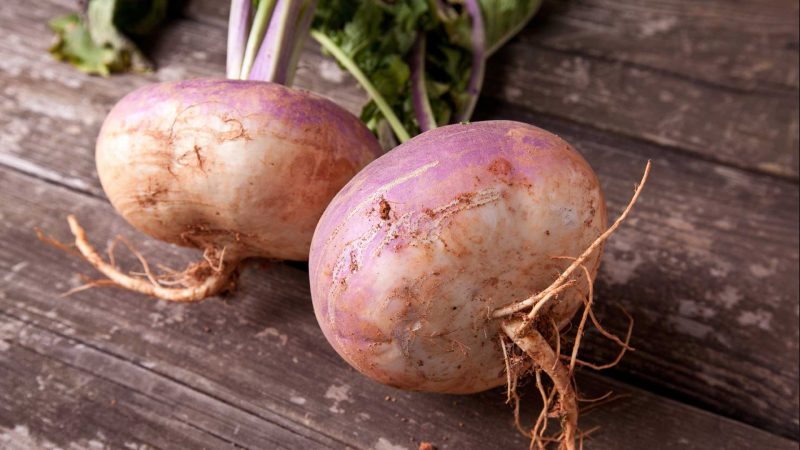
What is rutabaga? This is a vegetable that has been bred by crossing cabbage and turnips. The root crop inherited the form and dense structure from the second “parent”, but the rutabaga is somewhat larger. The density and color of the pulp also differ; in the hybrid, it is painted in a soft peach color and harder than in turnips.
The taste of these fruits is also different, and there is no characteristic bitterness in the swede. The chemical composition of the hybrid significantly exceeds turnips, for example, it contains more vitamin C and calcium.
Tip.Experienced culinary specialists claim that turnips are more suitable for eating raw, and it is better to cook rutabaga beforehand. The root crop is added to various dishes or eat separately.
Rutabaga - what is this vegetable, composition and nutritional value
Rutabaga is a member of the Cruciferous family. This culture has increased cold resistance, tolerates drought, while maintaining nutritional value.

The following useful substances are a part of a root crop:
- vitamins B1, B2, B4, B5, B6 and B9;
- Vitamin C
- Vitamin E
- vitamin K;
- vitamin P;
- beta carotene;
- lycopene;
- omega-3, omega-6 and omega-9;
- stearic and aspartic acids.
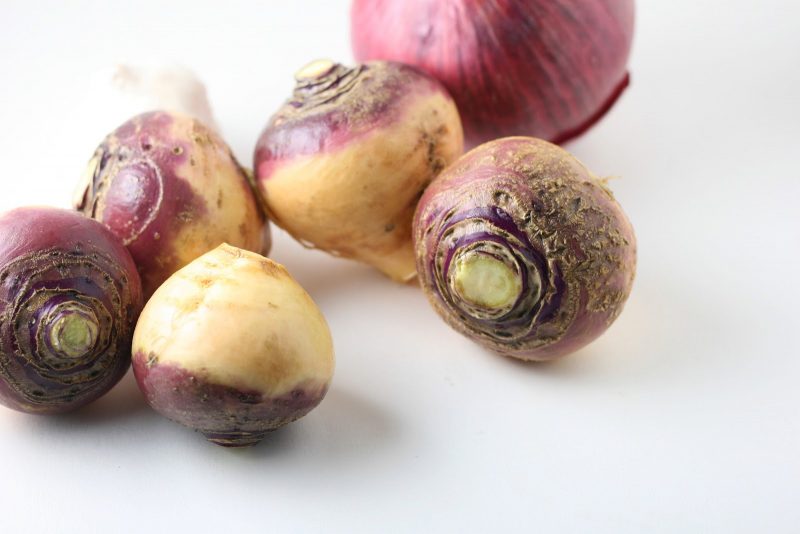
And also rutabaga is characterized by a high content of the following trace elements:
- gland;
- Selena;
- calcium:
- sodium;
- potassium;
- magnesium
- copper;
- manganese;
- phosphorus;
- zinc.
Calorie content of 100 g of the product is only 34.6 kcal.
Moreover, the rutabaga contains:
- 1.2 g of protein;
- 0.1 g of fat;
- 7.7 g of carbohydrates.
In addition to trace elements, rutabaga is rich in plant fiber, which helps to suppress hunger and quickly cleanse the intestines. Due to this, the root crop is often included in programs for weight loss.
Useful properties of rutabaga for the human body
As mentioned above, the root crop is actively used in traditional medicine.

Useful properties of rutabaga for the human body are as follows:
- removal of toxins from the body;
- getting rid of germs and parasites;
- stimulation of immunity;
- metabolic acceleration;
- diuretic and laxative effect;
- vascular strengthening and elimination of cholesterol plaques;
- removal of edema;
- activation of digestive processes;
- normalization of blood pressure;
- relief of inflammatory processes;
- removal of sputum from the lungs;
- strengthening of tooth and bone tissue;
- regenerative qualities.
Important! Cooking remedies or various dishes can only be made from rutabaga pulp, the root peel is too rough and eating it can lead to disruptions in the stomach and intestines.
Treatment of rutabaga diseases at home
For medicinal purposes, juice is most often used, as well as rutabaga pulp, crushed on a grater or in a blender.

Means based on this root crop are effective in the following diseases:
- Colds and SARS. It is necessary to grind the pulp to a state of gruel, mix with honey in a ratio of 2: 1. Take one teaspoon before meals with plenty of warm water.
- Acute and chronic diseases of the upper respiratory tract. In this case, you will need to grind the root crop and squeeze the juice out of the pulp. You need to use it 3-4 times a day, diluting with a rosehip broth, currant or cranberry juice.
- Constipation. In the presence of such problems, you can cook rutabaga puree or bake in its oven, cut into slices. Eat root vegetables 2-3 times a week, 150-200 g at a time.
- Cardiovascular disease and iron deficiency anemia. You will need to squeeze the juice from the grated pulp and drink it before eating 100 ml. The same remedy is also effective against edema associated with impaired renal function and heart problems.
- Diseases of the musculoskeletal system. It is necessary to mix juice squeezed from one fruit with 30 kg of honey and take twice a day.
- Body cleansing and weight loss. In this case, it is worth using rutabaga juice or eating grated root vegetables for food along with mushrooms or prunes.
- Burns, purulent rashes and other skin lesions. Compresses from crushed pulp of rutabaga will help to cope with these problems.
Attention! Means, prepared on the basis of rutabaga, in no way replace drugs, they only help to accelerate recovery.Treatment will be effective only with an integrated approach.
How is the vegetable used in cosmetology?
In addition to damage and skin diseases, rutabaga helps to cope with other cosmetic problems. On its basis, you can create a number of tools to improve the appearance.
Vitamin mask

To saturate the skin with vitamins, the mask is prepared according to the following recipe:
- Rutabaga is ground on a grater and mixed with 10 g of honey.
- Dilute the resulting composition with carrot juice.
- The mask is supplemented with 30-40 g of fat cottage cheese.
The product is applied to cleansed skin, and after a quarter of an hour it is washed off with warm water.
Moisturizer
A lack of moisture is one of the causes of premature skin aging. To delay this process, you need to mix the crushed pulp of rutabaga with the same amount of sour cream and apply on the face for a quarter of an hour. Such a procedure is allowed 2-3 times a week.
Compresses for cleansing
Rutabaga juice will help to cope not only with burns and purulent wounds, but also contribute to the disappearance of acne, blackheads and boils. To do this, you need to moisten a cotton pad or gauze in it and attach to the problem area for 30-40 minutes, and then rinse. With profuse acne, it is recommended to wipe the face with juice overnight.
Lightening tonic for freckles and age spots

To even out complexion, you will need to squeeze the crushed pulp of the root crop and mix the resulting liquid with a few drops of lemon juice. With this tool, wipe the face daily, treatment is carried out until the result.
What to cook from rutabaga - recipes
Dishes from rutabaga are tasty and easy to prepare, while they bring tangible benefits to the body and allow you to drown out the feeling of hunger for a long time. Below are the most common recipes based on this root crop.
Light salad of rutabaga and apples
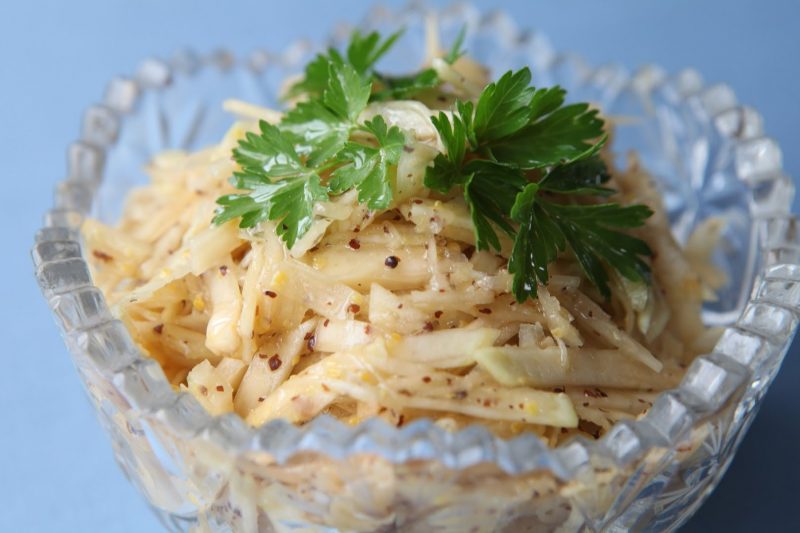
To prepare a salad, you can take apples of any kind, with a sour or sweet taste, which are more like. They will need to be cleaned of the stalks and the core, grind and mix with grated rutabaga. As a sauce, vegetable oil, sour cream or mayonnaise is suitable.
And to get great benefits from rutabaga salad and make the dish more saturated, you can add dried fruits, herbs, carrots or vegetables to the main ingredients.
Salad with rutabaga, radish and ham
This dish is more satisfying than the previous one.
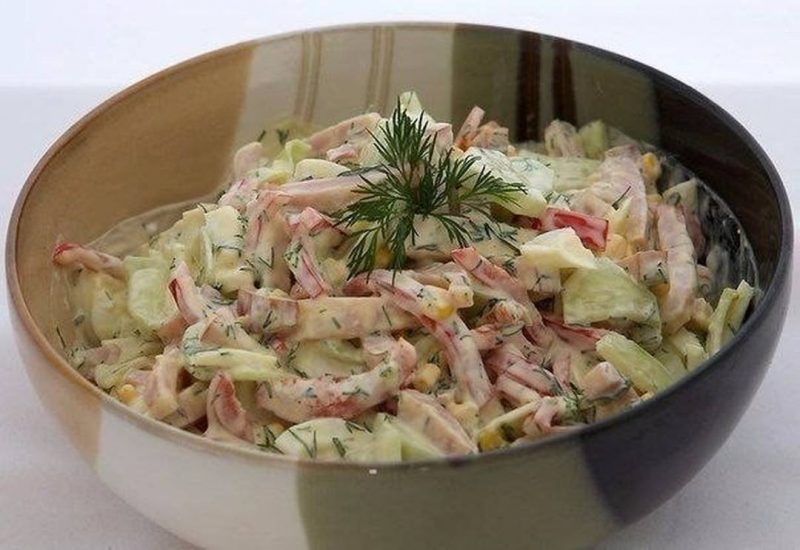
To prepare it, you need such products:
- swede;
- a bunch of radishes;
- 100 g of ham;
- green onions;
- egg;
- mayonnaise or sour cream.
All the ingredients will need to be chopped, and then mixed in a salad bowl, adding salt and sauce.
Rutabaga stuffed with mushrooms
To cook this dish, rutabaga will need to be pre-boiled for 1.5-2 hours.
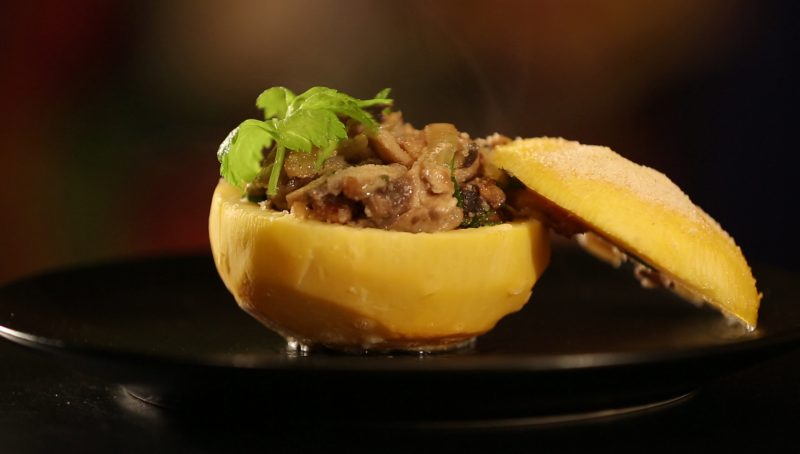
When the root crop is ready, you need to do the following:
- Carefully remove the pulp from the rutabaga, leaving the walls 7-10 mm thick.
- Fill the “cups” with mushrooms fried with onions. If desired, you can add grated carrots to the filling.
- Put the servings in a pan with thick walls, add water and simmer until tender, tightly closing the lid of the container.
Serve stuffed rutabaga with sour cream and herbs.
Rutabaga baked with cheese in the oven
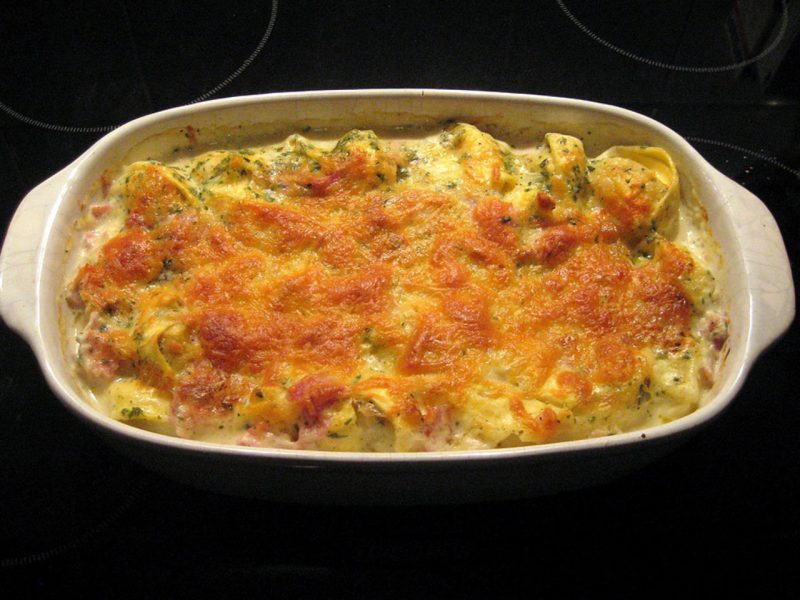
Baked rutabaga is tasty and healthy. To do this, the root crops are washed, cut into circles, mixed with salt, pepper, sour cream and bread in breadcrumbs, and then sent to the oven for a quarter of an hour. And a few minutes before taking out the finished dish, it is sprinkled with grated cheese.
Vegetable soup at home
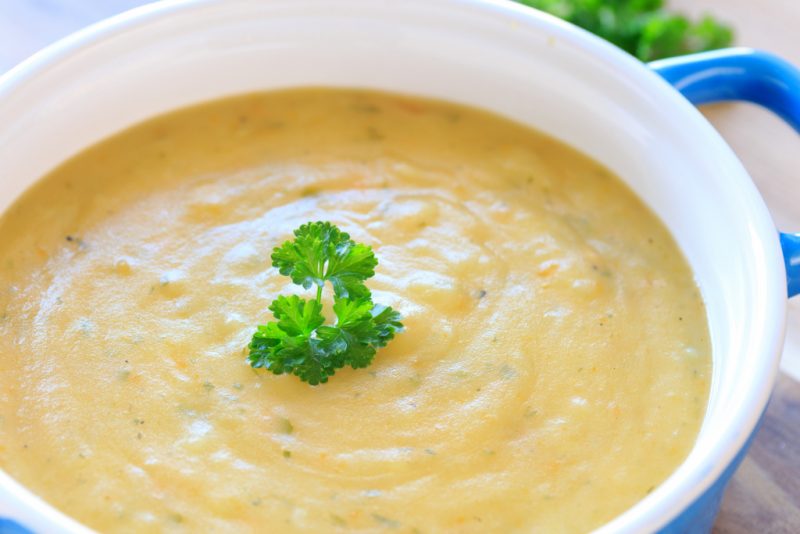
When cooking soup puree, in addition to rutabaga, you can take any vegetables. As an addition to the dish, cabbage, carrots, zucchini, potatoes, onions and garlic are suitable.
All components will need to be cut, folded into a pan and cook, then chopped in a blender, seasoned with salt and pepper. Serve the soup puree, sprinkling portions of finely chopped herbs.
Rutabaga dessert pudding
From a healthy root you can make a delicious dessert pudding.
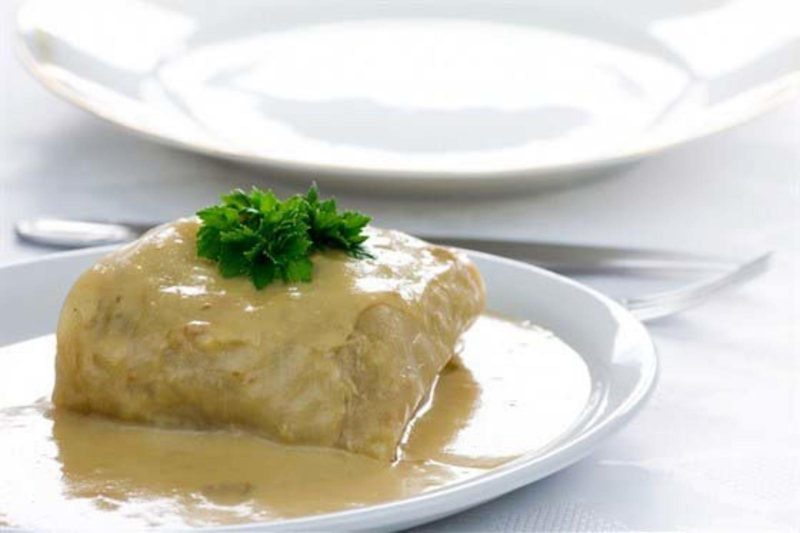
This will require the following components:
- swede;
- fat cottage cheese;
- 2 eggs;
- 50 ml of milk;
- butter;
- powdered sugar.
Grind the cottage cheese with eggs and melted butter, after which milk is added and beat thoroughly. Then the mass is laid out in a copiously greased form and baked in the oven until a golden crust appears. Before serving, dessert is sprinkled with powdered sugar.
Contraindications to the use of swede
Speaking about the benefits of rutabaga, we must not forget that it contains a large amount of coarse dietary fiber, which causes a reduction in the muscle layer in the intestines, in addition, its use can provoke flatulence. In addition, the product is rich in glucose, which leads to an increase in blood sugar.
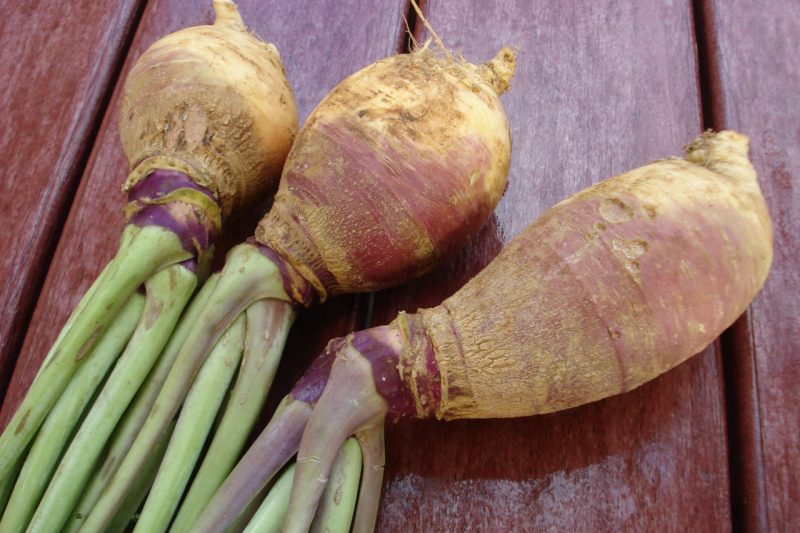
For these reasons, it is worth limiting the consumption of rutabaga or completely abandoning this product under the following conditions:
- ulcerative lesions of the stomach and intestines;
- gastritis and colitis in the acute stage;
- type 2 diabetes;
- flatulence;
- pregnancy and lactation.
Rutabaga is strictly contraindicated for children under 8-10 years old, since the digestive system at this age is not yet ready for digestion of heavy foods.
On a note. Like most foods, rutabaga can cause allergic reactions. One of the signs of intolerance is a dry cough, runny nose, and bloating.
How to grow rutabaga in the garden?
To grow rutabaga in a personal plot will not be difficult. To do this, you will need to prepare the soil in the fall, digging over the selected area, and then add humus and organic fertilizers.
In spring, you can plant seeds in the beds, deepening them by 3-4 cm, but it is better to prepare seedlings.
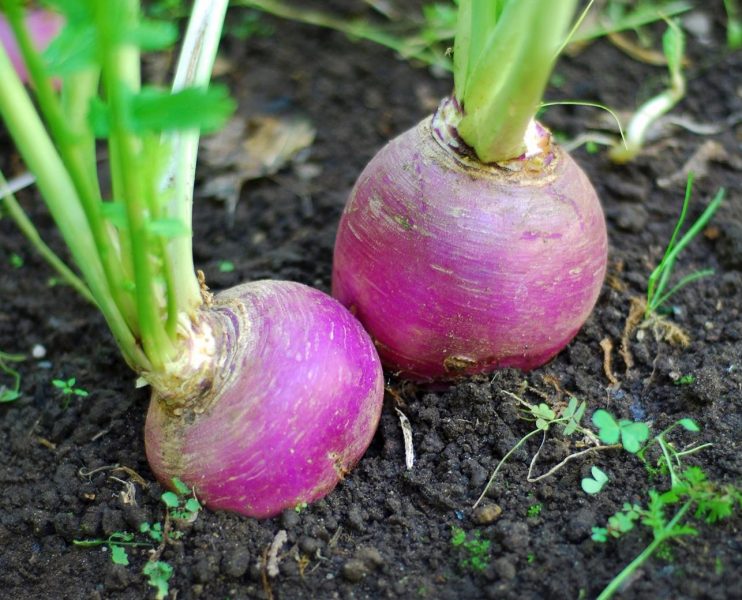
Do it this way:
- Sort planting material, discarding damaged or spoiled seeds.
- Spread the blanks on wet cheesecloth, laying a plastic bag, and send it to heat.
- After the appearance of the first sprouts, seeds are planted in a container with fertilized soil.
In late May or early June, when at least 3 leaves appear on the bushes, they are planted in beds, while the row spacing should be 40-50 cm.
The rutabaga will need to be weeded regularly, leaving a distance between plantings of 8-10 cm, watered and fed with organics. Harvesting is possible both before the start of frosts, and after their onset, the fruits of this will not die.
On a note. According to experienced summer residents, it is best to grow rutabaga in areas with a cold or temperate climate.












